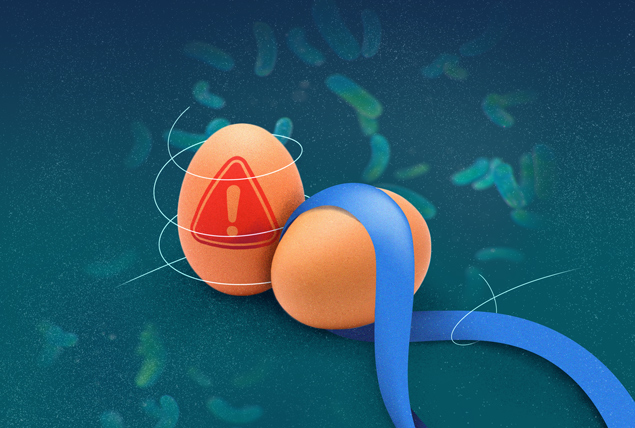What Should You Know About Chronic Endometritis?

Endometritis is an inflammation of the endometrium or the uterine lining that is most often caused by a bacterial infection. The condition usually isn’t dangerous and can be successfully treated with antibiotics.
However, unaddressed chronic endometritis can cause profound complications, including infertility and a heightened risk of life-threatening conditions such as ectopic pregnancy or sepsis.
Causes of endometriosis
Bacterial infections typically cause endometritis. Usually, these are ascending infections that travel from the vaginal canal, through the cervix and into the uterine cavity, according to Somi Javaid, M.D., an OB-GYN and the founder and chief medical officer at HerMD in Cincinnati.
Some examples of ascending infections include:
- Sexually transmitted infections (STIs), such as chlamydia and gonorrhea
- Tuberculosis
- Infections resulting from an imbalance in the vaginal microbiome
Infections can also develop through other means, according to experts, including:
- Childbirth
- Miscarriage or termination
- Insertion of an intrauterine device (IUD)
- Hysteroscopy
- Surgical procedures such as a dilation and curettage (D&C), myomectomy (removal of uterine fibroids) or cesarean section
“Basically, anytime the cervix is transversed—either with a delivery or an instrument—or the cervix dilates, there's an opportunity for that bacteria to ascend…and cause infection,” Javaid said.
Risk factors to consider
"Anyone with a uterus can develop endometritis," said Alyssa Dweck, M.D., a gynecologist in Westchester County, New York, and a sexual health and reproductive expert for Intimina, a brand of products focused on women's intimate health.
However, certain circumstances, behaviors and procedures can increase the likelihood of developing an inflammation in the lining of the uterus.
For non-pregnancy-related endometritis, health experts said the biggest risk factors are unprotected sex and high-risk sexual encounters that increase the likelihood of an STI. Your sexual partners should get regular STI screenings to help you prevent endometritis.
Lesser risks include having an IUD, having bacterial vaginosis or living in an area where tuberculosis is endemic.
The most prominent risk factors for postpartum endometritis, according to Comfort Ughanze, M.D., an OB-GYN at UTHealth Houston, are:
- Cesarean delivery
- Instrumental delivery
- Prolonged labor
- Group beta strep vaginal colonization
- Manual removal of the placenta
- Retained placenta
- Infected placenta
Miscarriage or termination can also make a person more vulnerable, particularly if the tissues are retained for a long time.
Symptoms of endometritis
According to Javaid and Cleveland Clinic, symptoms of endometritis include:
- Pelvic pain
- Fever
- Foul-smelling discharge
- Bleeding between periods
- Lower abdominal pain and swelling
- Constipation
- Discomfort during bowel movements
- A general feeling of being unwell
Endometritis isn’t the same as pelvic inflammatory disease
Endometritis and pelvic inflammatory disease (PID) involve inflammation of the uterus, produce similar symptoms and frequently co-occur, but they are not synonymous with each other.
"If you think about the uterus, it has three layers—like an orange, that's how I would describe it," Javaid said. "The innermost layer is the endometrium. So an infection that's there is endometritis. The muscular layer, or like the fruit of an orange, is the myometrium, and then the outside is the serosa. When we talk about pelvic inflammatory disease, that is when it has ascended beyond that layer and has gone into the fallopian tubes or the belly."
Both conditions can be asymptomatic, Javaid continued, but PID almost always produces notable symptoms, including high fever, pelvic pain and foul-smelling vaginal discharge.
Other PID symptoms, per the Centers for Disease Control and Prevention (CDC), include pain or bleeding during sex, a burning sensation while urinating and bleeding between periods.
Like endometritis, PID is caused by a bacterial infection, most commonly chlamydia and gonorrhea.
If you experience symptoms, schedule an appointment with your doctor.
Diagnosis of endometritis
According to Cleveland Clinic, diagnosing endometritis begins with a pelvic exam to check for inflammation and pain.
A healthcare provider might also:
- Test vaginal fluid for STIs or bacterial infections, such as bacterial vaginosis
- Perform a laparoscopy to examine the uterus more closely
- Take a biopsy of the uterus to test for bacteria
- Take a blood test to look for markers of inflammation, including a high white blood cell count (WBC) or erythrocyte sedimentation rate (ESR)
Treatment for endometritis
Antibiotics are the primary treatment for endometritis. A typical course is 10 to 14 days, at which point the infection and inflammation should clear up rather quickly, according to Monte Swarup, M.D., an OB-GYN in Chandler, Arizona, and the founder of HPV HUB.
In certain circumstances—if someone has just given birth or had surgery, or if they’re unable to tolerate oral medications—intravenous antibiotics might be necessary, according to Javaid.
Long-term implications of endometritis
Untreated endometritis can cause severe, long-term symptoms and complications, according to Javaid and Dweck.
These symptoms or complications can include:
- Chronic pain
- Uterine cavity scarring
- Fertility issues
- Pelvic or uterine abscesses
- Blood infection (septicemia)
Very rarely, a severe infection can cause septic shock, a life-threatening condition that requires immediate medical care.
Prompt diagnosis and proper treatment can typically prevent serious problems, according to Dweck.
The effects of endometritis on fertility
Many people with endometritis can fully recover, become pregnant and deliver healthy babies. However, an active infection can make it difficult to become pregnant and complicate the birthing process, according to Swarup.
"Endometritis during labor can slow the contractility of the uterus, increasing the risk of a cesarean section. It can also be associated with infection around the baby called chorioamnionitis," he explained. "This can affect the baby negatively, but the baby and mom usually recover very well with antibiotics once they are separated."
Complications from endometritis can also inhibit fertility after the disease has cleared. These issues typically occur with chronic endometritis and associated fallopian tube infections, tubal ovarian abscesses and scar tissue, Ughanze and Javaid said.
"Unfortunately, you can end up with scarring in the uterus or in the pelvis because the infection can keep ascending through the uterus into the fallopian tubes, which are attached, and then on into the pelvis," Javaid said.
Even if abscesses are surgically removed, she continued, the resulting scar tissue can produce a cobweb effect, which can interfere with conception and increase the risk of ectopic pregnancy. This nonviable pregnancy can endanger a pregnant person’s life.
Javaid said that if someone is diagnosed with one of the complications of endometritis and wants to become pregnant, there are ways to determine if the fallopian tubes are open or blocked.
"There is a really elegant test now that we can do in the office. It's called FEMVue. It's an ultrasound test, and we use ultrasound, saline and air bubbles," she said. "Basically, we place a speculum in the vagina. We then gently place a catheter into the cervix and gently put in the water and air. If you can see bubbles on either side, then you know the fallopian tubes are open. It's a much kinder, gentler way to perform what used to be called an HSG."
An HSG (hysterosalpingography) involves injecting dye into the uterus and using an X-ray to determine if the fallopian tubes are blocked. Unlike the new test, which can be performed in the doctor’s office, an HSG usually occurs in a hospital radiology department.
If a blockage is present, a doctor may be able to remove it via fallopian tube recanalization or surgery, depending on the extent of the damage and its location. However, because fallopian tubes are so fragile, unblocking them without injury isn’t always possible. In these instances, a person might need to consider assisted reproductive technology (ART) to conceive.














